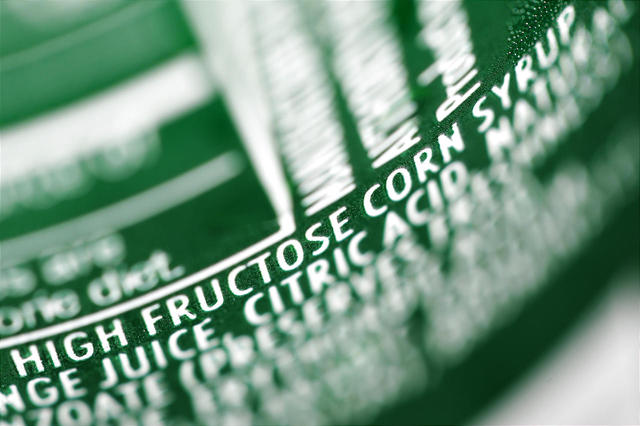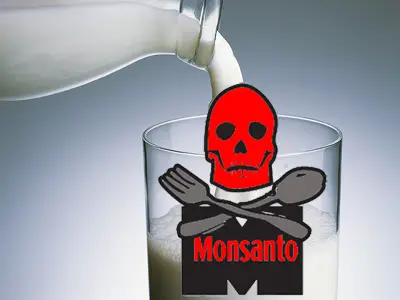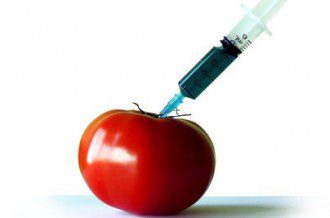Guest writer for Wake Up World
In the very short time since GMO foods were first introduced, they have tainted ecosystems, created financial strains for farmers, and introduced unnatural elements into the local, national, and global food supply.
GMOs pose a danger to all of us and the evidence is irrefutable. Environmentally, they have created superweeds that destroy farmland, and they have eliminated some organisms from ecosystems, leading to new superbugs to fill the void. Much talk also centers around the health considerations. Unfortunately, researchers who attempt to test the alleged safety of these GMOs – and have found them decidedly unsafe! – get shouted down by the rank-and-file industry yes men who are intent on protecting the empire. Despite this, the research has shown a dramatically higher risk of health problems from eating GMOs and research shown that toxic DNA from these plants may survive digestion. It’s even been found in the blood of pregnant women and their fetuses! [1]
[pro_ad_display_adzone id=”110028″]
Unfortunately, until the laws change and ban these destructive products, the best protection is to avoid them. The following list outlines the 20 top GMO foods and ingredients you should absolutely avoid, to ensure the best possible health for you and your family.
1. Aspartame
According to the EPA, aspartame is a chemical that causes neurotoxicity. Keep in mind that that’s the United States Environmental Protection Agency — a government agency. Regardless, the FDA continues to rubber stamp its use.
Aspartame is made from aspartate, methanol, and phenylaline. Once ingested, the body breaks aspartame down into these constituent parts. Most notably, methanol is converted into formaldehyde. The US Department of Labor considers formaldehyde a toxic and hazardous substance that should not be ingested.
Recent research has demonstrated highly carcinogenic affects from aspartame consumption. [2] Additional research could not dismiss aspartame’s role in leukemia and non-Hodgkins lymphomas. [3] Entire books have been written about the dangers of aspartame.
In the quest for healthy living, this toxic, lab-created chemical tops any list of foods and ingredients to avoid!
2. Corn
The agribusiness cartels have assured us for years of their products safety and the mainstream media have smiled and winked right alongside them. However, now, even MSN is now reporting that GMO corn may be toxic. [4] Several studies have shown regular dietary consumption of Bt-corn (maize), the GMO version of corn, leads to serious health problems and negatively effects the kidney and liver (the dietary detoxifying organs), as well as in the heart, adrenal glands, and spleen. [5] [6]
Eating organic corn may be one way to eliminate exposure to this dangerous GMO. As you will see below, corn appears in many more forms, making avoidance an exercise in awareness.
3. Sugar Beets
Of the nearly 130 million metric tons of sugar produced globally every year, sugar beets constitute nearly 35% of that sugar (the remaining amount coming from sugar cane). [7] These sugar beets are used to produce sucrose. [8]
Unfortunately, they struggle to survive competition from weeds. So a glyphosate (Roundup) version was created. [9] That way farmers could dump Roundup on the fields of sugar beets to kill off the weeds without killing the sugar beets. Great idea — in addition to the glyphosate DNA, the plants are repeatedly coated with toxic chemicals during their growing cycle.
The best way to avoid sugar beets is to avoid products with sucrose (sugar), or any product that doesn’t specify sweeteners like organic agave or raw honey.
4. HFCS (High Fructose Corn Syrup)
 First, HFCS is made from corn, which is likely to be a GMO strain. It then goes through a process that converts corn into corn starch… which then is converted into corn syrup in a process involving bacterial enzymes and fungus. Finally, another bacterial enzyme is added to the process to produce fructose. This is not a natural process and does not yield a natural product.
First, HFCS is made from corn, which is likely to be a GMO strain. It then goes through a process that converts corn into corn starch… which then is converted into corn syrup in a process involving bacterial enzymes and fungus. Finally, another bacterial enzyme is added to the process to produce fructose. This is not a natural process and does not yield a natural product.
Mercury has been found in HFCS as a result of the manufacturing process. [10] Does HFCS lead to health problems? Possibly, researchers from Princeton and Oxford have linked HFCS to weight gain and Type II diabetes. [11] [12]
To summarize, HFCS starts as a GMO, contains mercury, and has been linked to weight gain and Type II diabetes. Just avoid it.
5. Soy (Lecithin)
Soy beans are perhaps one of the most prevalent GMO products in fields today. Soy has been associated with a wide range of health problems and GMO soy has been linked to pancreatic problems. [13]
Soy lecithin isn’t even a choice soybean product, it’s a waste product from the processing of crude soy oil. It typically contains solvents and pesticides. Researchers have also found soy lecithin to contain allergens that have wide ranging health impacts. [14]
As a rule, avoid soy unless it is organic and fermented (such as in miso or natto). And make sure to avoid anything containing soy lecithin, the soy product constructed from the sludgy glop created during the creation of soy oil.
6. Corn Starch
Corn starch is a highly processed corn product made from corn – genetically modified (GM) corn. It offers no nutritional value and carries all the dangers associated with GMO foods. It is used as an additive in many products and as a processed food, it creates digestive problems. The problems with corn starch have been known about since the 1970s. With the introduction of GMO corn, the problems have only increased.
7. Tomatoes
When tested, genetically modified tomatoes have been found to have less antioxidant activity than their natural counterparts. [15] As is the case with GMOs, the genetic modifications result in overall reduced nutritional value.
8. Sausage
Most sausage contains corn syrup or corn syrup solids, in addition to the other preservatives. That’s right, the hot dog or Italian sausage you enjoy – even just once in a while – likely contains a GMO. If you choose to eat sausage of any type, avoid the pre-packaged kind. Your best bet is to purchase from a local butcher who specializes in locally grown, organic, free-range meats.
[pro_ad_display_adzone id=”110030″]
9. Ice Cream
This delicious summer-time treat typically features a range of HFCS, corn syrup and corn starch, plus rGBH. Unless the brand you buy is organic or home-made from organic ingredients, each spoonful of ice cream likely contains plenty of genetically-modified DNA and bovine growth hormones.
10. Non-Organic and Synthetic Vitamins
Many vitamins, including top children’s vitamins, use ‘vegetable’ products as a base for the vitamin. Many of these ‘vegetables’ come from corn and soy products; many also contain aspartame and hydrogenate oils. Look for vitamins that are specifically organic or non-GMO.
11. Infant Formula
Milk that contains rGBH and genetically modified soy consitute the foundation for most infant formulas, unless they specifically state they are organic. Research has found that infant diets including formulas that contain these GMOs contribute to chronic, long-term health conditions. [16]
12. Beef
Beef feed may contain GMO alfalfa, corn and soy. When cows eat GMOs, they get into their system and become part of the meat. If you’re going to eat beef, only consume organic, grass-fed beef.
13. Milk
Why let nature do things naturally when Monsanto’s recombinant Bovine Growth Hormone (rGBH) can be injected right cows to increase milk output. Never mind that hormones associated with rBGH have been found present in milk distributed for human consumption. Or that studies have also found milk from cows injected with rGBH contain reduced amounts of healthy fatty acids. [17] Or that these cows are more likely to have mastitis, an udder infection that can lead to blood and pus in the milk. Yuck.
 You can buy organic milk or goat milk and avoid bovine growth hormones. However, to keep all bovine growth hormones out of the diet, you also need to watch out for foods that contain milk products, as these may come from hormone-injected cows.
You can buy organic milk or goat milk and avoid bovine growth hormones. However, to keep all bovine growth hormones out of the diet, you also need to watch out for foods that contain milk products, as these may come from hormone-injected cows.
14. Alfalfa
Although GMO alfalfa planting had been halted, as of this year, GM alfalfa returns to the fields. [18] Alfalfa is the backbone of the dairy industry, both organic farmers and industry groups. So dairy, beef, and alfalfa will all be affected. As an insect pollinated plant, cross pollination of GMO plants and non-GMO plants will likely result.
15. Vegetable Oil
Vegetable Oil typically comes from corn, soybean, cotton, or canola oils. All of these crops have been genetically modified to withstand being doused by Roundup. Unless the vegetable oil states it is organic, assume it may contain some degree GMOs.
16. Canola Oil
Canola oil gets its own category due to its prevalent use. Aside from questions about an oil made from a plant toxic to human consumption, the rapeseed has been genetically altered. As of 2009, 90% of Canada’s rapeseed crop was ‘herbicide-tolerant’. [19] When it comes to cooking oils, the best option is to find products specifically designated non-GMO.
17. Margarine and Shortening
These are another form of vegetable oil and contain all the GMO problems the vegetable oils contain. To avoid GMOs from margarine, organic butter may be an option.
18. Hawaiian Papaya
This type of genetically modified papaya primarily affects those living on the west coast. Its GMO attribute is that its a virus-resistant plant specific to Hawaii and the areas that import papaya from Hawaii. This plant contains DNA from the Ringspot virus, as do individuals who choose to eat it.
19. Squash
Many squash varieties have been genetically modified to fight off the diseases that can affect them. When it comes to squash, buy organic.
20. Flax
GMO flax has been grown (illegally, for what it’s worth) in Canada. The extent of Canadian contamination has not yet been determined. Reports also indicate that the GM flax has been exported around the world where contamination has occurred. [20] Because of the environmental catastrophe of this rogue GM strain, identify the source of the flax used before you buy. Flax from Canada may be infected, as well as from many areas of the EU.
A Final Thought…
When it comes to avoiding GMOs, the best answer is to search for foods that have been labeled as non-GMO. If unsure, ask at the store or contact the manufacturer of the product. If you find out it may contain GMOs, let them know they’ve lost your business. Once GMOs become a marketing liability, then the industry itself will reject GMOs.
Have you stopped consuming GMOs and/or detoxed yourself from them? Please share your experience with us by leaving a comment below, or join the conversation on Facebook.
References:
- Aris A, Leblanc S. Maternal and fetal exposure to pesticides associated to genetically modified foods in Eastern Townships of Quebec, Canada. Reprod Toxicol. 2011 May;31(4):528-33. doi: 10.1016/j.reprotox.2011.02.004. Epub 2011 Feb 18.
- Soffritti M, Belpoggi F, Degli Esposti D, Lambertini L, Tibaldi E, Rigano A. First experimental demonstration of the multipotential carcinogenic effects of aspartame administered in the feed to Sprague-Dawley rats. Environ Health Perspect. 2006 Mar;114(3):379-85.
- Schernhammer ES, Bertrand KA, Birmann BM, Sampson L, Willett WC, Feskanich D.Consumption of artificial sweetener- and sugar-containing soda and risk of lymphoma and leukemia in men and women. Am J Clin Nutr. 2012 Dec;96(6):1419-28. doi: 10.3945/ajcn.111.030833. Epub 2012 Oct 24.
- MSN. Leaked study finds GMO corn may not be that safe after all. (last accessed 2013-07-24)
- Séralini GE, Clair E, Mesnage R, Gress S, Defarge N, Malatesta M, Hennequin D, de Vendômois JS. Long term toxicity of a Roundup herbicide and a Roundup-tolerant genetically modified maize. Food Chem Toxicol. 2012 Nov;50(11):4221-31. doi: 10.1016/j.fct.2012.08.005. Epub 2012 Sep 19.
- Joël Spiroux de Vendômois JS, Roullier F, Cellier D, Séralini GE. A comparison of the effects of three GM corn varieties on mammalian health. Int J Biol Sci. 2009 Dec 10;5(7):706-26.
- Robert M. Harveson. Sugarbeet Production in Nebraska: An Abbreviated History.2015. 4 Mar. 2016
- A.W. Cattanach A.G. Dexter, and E.S. Oplinger. Sugarbeets. Alternative Field Crops Manual. (last accessed 2013-07-24)
- Esther E. McGinnis, Mary H. Meyer and Alan G. Smith. Sweet and Sour: A Scientific and Legal Look at Herbicide-Tolerant Sugar Beet. Published online before print June 2010, doi: http:/?/?dx.?doi.?org/?10.?1105/?tpc.?110.?077198 The Plant Cell June 2010 vol. 22 no. 6 1653-1657.
- Dufault R, LeBlanc B, Schnoll R, Cornett C, Schweitzer L, Wallinga D, Hightower J, Patrick L, Lukiw WJ. Mercury from chlor-alkali plants: measured concentrations in food product sugar. Environ Health. 2009 Jan 26;8:2. doi: 10.1186/1476-069X-8-2.
- Hilary Parker. A sweet problem: Princeton researchers find that high-fructose corn syrup prompts considerably more weight gain. News at Princeton. March 22, 2010. (last accessed 2013-07-24)
- University of Oxford. Research indicates risks of consuming high fructose corn syrup.(last accessed 2013-07-24)
- Magaña-Gómez JA, Cervantes GL, Yepiz-Plascencia G, de la Barca AM. Pancreatic response of rats fed genetically modified soybean. J Appl Toxicol. 2008 Mar;28(2):217-26.
- Gu X, Beardslee T, Zeece M, Sarath G, Markwell J. Identification of IgE-binding proteins in soy lecithin. Int Arch Allergy Immunol. 2001 Nov;126(3):218-25.
- Venneria E, Fanasca S, Monastra G, Finotti E, Ambra R, Azzini E, Durazzo A, Foddai MS, Maiani G. Assessment of the nutritional values of genetically modified wheat, corn, and tomato crops. J Agric Food Chem. 2008 Oct 8;56(19):9206-14. doi: 10.1021/jf8010992. Epub 2008 Sep 10.
- Aifric O’Sullivan, Xuan He, Elizabeth M. S. McNiven, Neill W. Haggarty, Bo Lönnerdal, and Carolyn M. Slupsky. Early Diet Impacts Infant Rhesus Gut Microbiome, Immunity, and Metabolism. J. Proteome Res., 2013, 12 (6), pp 2833–2845 DOI: 10.1021/pr4001702.
- O’Donnell AM, Spatny KP, Vicini JL, Bauman DE. Survey of the fatty acid composition of retail milk differing in label claims based on production management practices. J Dairy Sci. 2010 May;93(5):1918-25. doi: 10.3168/jds.2009-2799.
- Rosenblatt, Joel. Monsanto Alfalfa Can’t Be Limited as Plant Pest, Court Says. (last accessed 2013-07-24)
- Beckie, Hugh et al (Autumn 2011) GM Canola: The Canadian Experience. Farm Policy Journal, Volume 8 Number 8, Autumn Quarter 2011. Retrieved 20 August 2012.
- GMO Contamination Register. FP967 (‘Triffid’) flax has been gown illegally in Canada and exported around the globe. (last accessed 2013-07-24)
About the author:
Dr. Edward F. Group III (DC, ND, DACBN, DCBCN, DABFM) founded Global Healing Center in 1998 and is currently the Chief Executive Officer. Heading up the research and development team, Dr. Group assumes a hands-on approach in producing new and advanced degenerative disease products and information.
Dr. Group has studied natural healing methods for over 20 years and now teaches individuals and practitioners all around the world. He no longer sees patients but solely concentrates on spreading the word of health and wellness to the global community. Under his leadership, Global Healing Center, Inc. has earned recognition as one of the largest alternative, natural and organic health resources on the internet.
For more information, please visit Global Healing Center.
Recommended articles by Dr. Group:
- The 9 Best Fermented Foods for Your Gut
- 14 Foods that Cleanse the Liver
- How Turmeric Keeps You Looking Young
- 7 Toxins Harming Your Brain Right Now
- Top 5 Foods for the Pineal Gland
- 6 Things You Must Know About Colloidal Silver
- The Importance of a Kidney Cleansing Diet
- The 9 Best Herbs for Lung Cleansing and Respiratory Support
- 7 Best Foods to Support Kidney Function
- Lung Cleansing With Peppermint Oil
- How Fluoride Damages Pineal Gland Health
Please note: All information and statements made are for education purposes and are not intended to replace the advice of a healthcare professional. Neither Global Healing Center nor Wake Up World dispenses medical advice, prescribes, or diagnoses illness.
[pro_ad_display_adzone id=”110027″]








